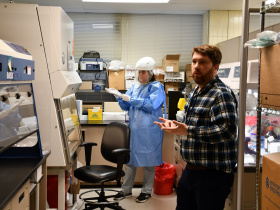New Tool Allows You To See Flu, RSV Activity in Milwaukee
Health Department unveils new dashboard powered by your toilet.
There’s a new, easy-to-use tool to help inform the public how widespread flu and RSV are, and what steps can be taken to avoid contracting the diseases.
The Milwaukee Health Department launched a dashboard to track the respiratory illnesses.
The data comes from an increasingly used, but unusual source: wastewater.
Humans, even those without visible symptoms, pass viruses in their waste and measuring the concentrations over time can reveal the prevalence of a disease in a community.
Using twice-a-week samples collected from the Milwaukee Metropolitan Sewerage District‘s Jones Island and South Shore treatment plants, a series of machines in the MHD lab in the Zeidler Municipal Building extracts and processes the samples to determine the concentration of various diseases.
The surveillance strategy became popular during the COVID-19 pandemic, especially as fewer cases were reported with the surge in availability of at-home tests and fewer people needing medical care.
During a tour of the lab, MHD officials said the data is valuable because it is collected proactively rather than reactively. Using stoplight-styled gating criteria, specific health interventions are suggested by virus, ranging from washing your hands regularly (low) to avoiding non-essential indoor activities (high).
MHD epidemiologist Cait McCrory said it is important to follow the trendline in the data, rather than trying to observe individual data points.
RSV is on a sustained upward trend since early November, while the spread of the flu is barely registering.
“We are just now starting to see detections after a really long period of not having a lot of RSV getting picked up,” said McCrory.
The prevalence of RSV has been switched to red (high). COVID-19 trended down from a late summer high, but is again on an upward swing.
“Thankfully, we’re so far having kind of a light respiratory season, but we are starting to see the uptake,” said lab director David Payne.
MHD began testing samples for COVID in fall 2021. It’s been internally testing for RSV and flu, divided into flu A and flu B, to validate its results for many months before publishing the data.
Payne said he expects more agencies to follow suit in adding more disease types.
But MHD could add even more diseases. It could also further synthesize the samples to determine specific strains of viruses.
The lab director said the technology exists in MHD’s lab, but it would mean an additional cost. The effort, so far, is grant funded. “It is still not a trivial expense of time or money,” said Payne.
After a sample arrives at the lab, senior microbiologist Julia Zimmer said it takes about six hours total to get a result. That includes technicians, including Zimmer, donning protective gear when handling the samples. The final step includes a high-end machine using a digital PCR process to detect the concentration of a specific virus’ RNA from a tray that holds more than 600,000 individual wells. MHD was able to buy the machines, with COVID-19-related funding, for approximately $35,000 each and can now use them to test for a variety of viruses.
Individuals using the dashboard are recommended to do so from a desktop computer. And users do need to select whether they want to see data from the Jones Island or South Shore treatment plant, though MHD officials said they don’t expect to the trend lines to differ. However, the data cannot be combined, said McCrory, because Jones Island processes wastewater from the combined sewer system, and the inclusion of stormwater often causes concentration levels to be lower.
Want to see what’s happening in more cities? The Wisconsin Department of Health Services operates a COVID-19 wastewater dashboard with data from several cities.
Photos

Existing members must be signed in to see the interactive map. Sign in.
If you think stories like this are important, become a member of Urban Milwaukee and help support real, independent journalism. Plus you get some cool added benefits.


























